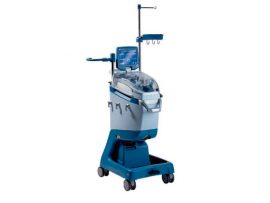Abstract Extracorporeal Membrane Oxygenation (ECMO) is a technology that offers organ support for critically ill patients with respiratory and/or cardiac failure. Despite improvements in recent years in technology and the..
Read MoreAbstract Objective Several machine learning (ML) models have been used in perioperative red blood cell (RBC) transfusion risk for cardiac surgery with limited and no external validation. Hence, we sought to..
Read MoreAbstract Background: The conventional method of heparin and protamine management during cardiopulmonary bypass (CPB) is based on total body weight which fails to account for the heterogeneous response to heparin in each patient...
Read MoreAbstract Objectives Despite significant improvement in patient blood management, cardiac surgery remains a high hemorrhagic risk procedure. Platelet transfusion is used commonly to treat thrombocytopenia-associated perioperative bleeding. Allogeneic platelet transfusion..
Read MoreAbstract Background Anemia, characterized by low hemoglobin levels, is a global public health concern. Anemia is an independent factor worsening outcomes in various patient groups. Blood transfusion has been the..
Read MoreAbstract BACKGROUND: Cardiac surgery with cardiopulmonary bypass (CPB) is associated with hemolysis. Yet, there is no easily available and frequently measured marker to monitor this hemolysis. However, carboxyhemoglobin (CO-Hb), formed..
Read MoreAbstract Objective Professional standards recommend stopping cardiotomy suction at the termination of cardiopulmonary bypass before protamine administration based on perceived safety concerns. This study evaluated a multidisciplinary collaborative quality-improvement intervention..
Read MoreAbstract Few data describe pediatric patients who receive massive transfusion for life-threatening hemorrhage (LTH) while on extracorporeal membrane oxygenation (ECMO). We present a retrospective secondary analysis of a multicenter prospective..
Read MoreAbstract Introduction: Intraoperative ultrafiltration (UF) is a procedure used during cardiopulmonary bypass (CPB) to reduce haemodilution and prevent excessive blood transfusion. However, the effect of UF volume on acute kidney injury..
Read MoreAbstract Background This study investigated whether intraoperative blood salvage was associated with coagulation disorder diagnosed by conventional coagulation tests and thromboelastography (TEG) after cardiopulmonary bypass (CPB). Study design and methods..
Read MoreAbstract Background: En bloc removal of the kidney with tumor thrombus excision in a multidisciplinary team remains the standard treatment for renal cell carcinoma (RCC) with tumor thrombus extension. In..
Read MoreAbstract Background One of the leading causes of maternal death worldwide is severe obstetric haemorrhage after childbirth. Use of intraoperative cell salvage is strongly recommended by international guidelines on patient..
Read MoreAbstract BACKGROUND: Preoperative anemia is associated with adverse outcomes in cardiac surgery, yet it remains unclear what proportion of this association is mediated through red blood cell (RBC) transfusions. METHODS: ..
Read MoreAbstract Objectives The aim of this study was to evaluate the incidence of transfusions, including red blood cells (RBC), platelets, and fresh frozen plasma (FFP) during and after coronary artery..
Read MoreAbstract Background Bleeding after cardiac surgery is common and continues to require 10–20% of the national blood supply. Transfusion of allogeneic blood is associated with increased morbidity and mortality. Excessive..
Read MoreAbstract Background The decision regarding intraoperative transfusion has traditionally been based on hemodynamic instability and estimated blood loss. We performed a systematic review to determine the validity of the oximetry..
Read MoreAbstract BACKGROUND: Pediatric patients requesting bloodless care represent a challenging clinical situation, as parents cannot legally refuse lifesaving or optimal interventions for their children. Here, we report clinical outcomes for..
Read MoreAbstract Acute kidney injury (AKI) after cardiac surgery is a common complication that can lead to death. We previously reported that the creatinine reduction ratio (CRR) serves as a useful..
Read MoreAbstract Background In on-pump cardiac surgery, the albumin priming strategy could maintain colloid osmotic pressure better than crystalloid solutions and reduce excessive perioperative fluid balance. However, a high-quality meta-analysis is..
Read MoreAbstract Background The risks and benefits of preoperative aspirin continuation in patients undergoing isolated heart valve replacement surgery are unclear. We investigated the effect of aspirin continuation on the risk..
Read MoreAbstract Background: Acute kidney injury (AKI) is a common and serious complication after the repair of Type A acute aortic dissection (TA-AAD). However, previous models have failed to account for the..
Read MoreAbstract Objective The hemoglobin threshold for a decision to transfuse red blood cells in univentricular patients with parallel circulation is unclear. A expertise initiative put forth a “weak recommendation” for avoiding..
Read MoreAbstract OBJECTIVE Excess blood loss from obstetrical hemorrhage requires transfusion of donor blood, a finite resource. Intraoperative cell salvage collects a patient's own blood that has been lost during cesarean..
Read MoreAbstract Type A aortic dissection (TAAD) is a life-threatening disease with high mortality and poor prognosis, usually treated by surgery. There are many complications in its perioperative period, one of..
Read MoreAbstract Introduction The point-of-care test (POCT) is useful for blood coagulation management during cardiovascular surgery. Although thromboelastography (TEG6s) has been reported to have targeted benefits for blood transfusion in cardiac..
Read MoreAbstract Objectives To compare the incidences of postoperative thrombotic complications, transfusion of blood products, and chest tube output in congenital cardiac surgical patients who received either recombinant activated factor VII..
Read MoreAbstract Background Platelets (PLTS) and fresh frozen plasma (FFP) are often transfused in cardiac surgery patients for perioperative bleeding. Their relative effectiveness is unknown. Methods We conducted an entropy-weighted retrospective..
Read MoreAbstract Data collection, analysis, and reporting are fundamental for a successful hospital-based patient blood management program; however, very little has been published on the topic. Our aim was to synthesize..
Read MoreAbstract Introduction Fresh frozen plasma (FFP) transfusion in the intensive care unit (ICU) is commonly used to treat coagulopathy and bleeding in cardiac surgery, despite suggestion that it may increase..
Read MoreAbstract Purpose: This study aimed to assess the necessity of routine intraoperative cell salvage in liver transplantations. Methods: A total of 327 liver transplants performed between 2014 and 2016 was..
Read More












